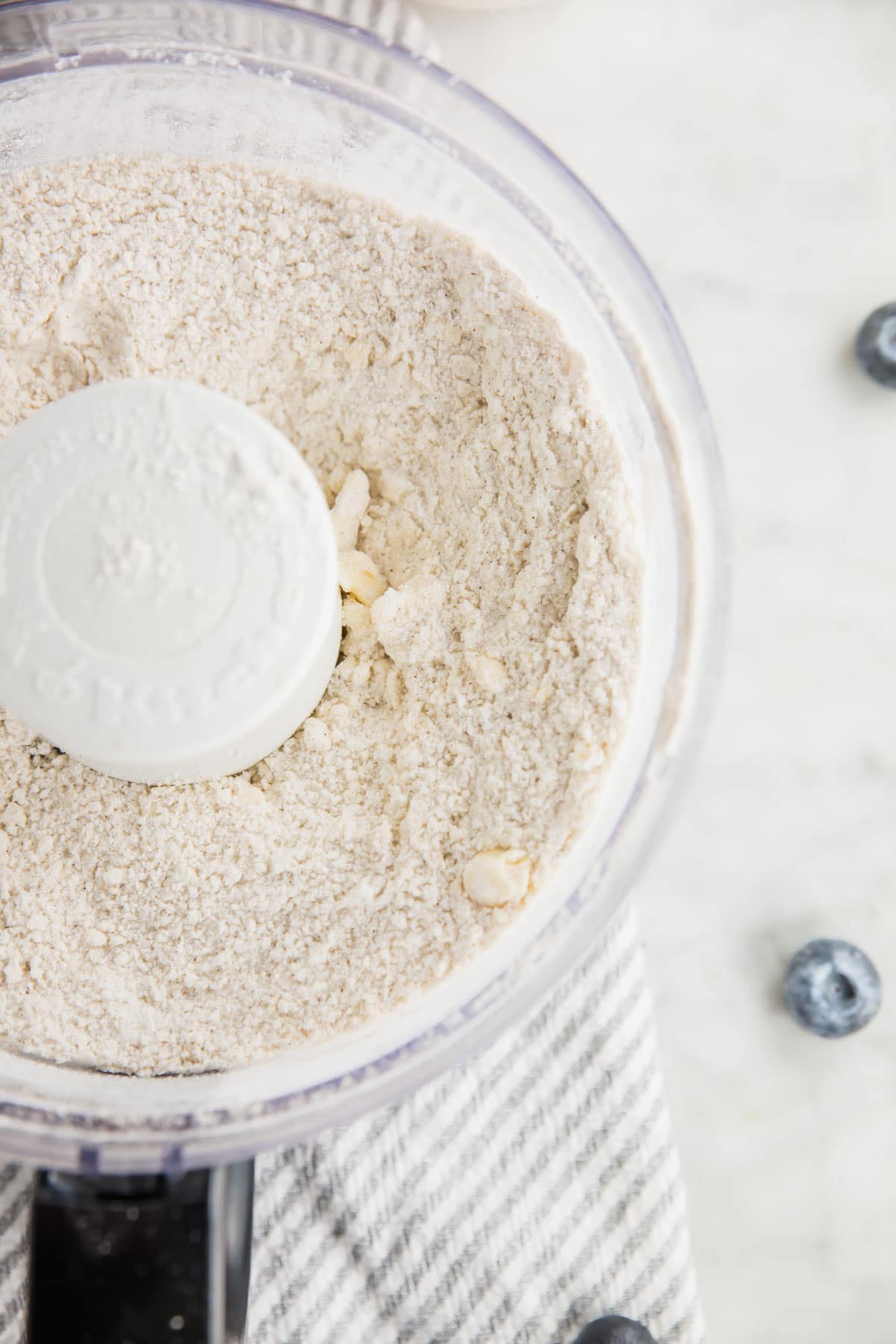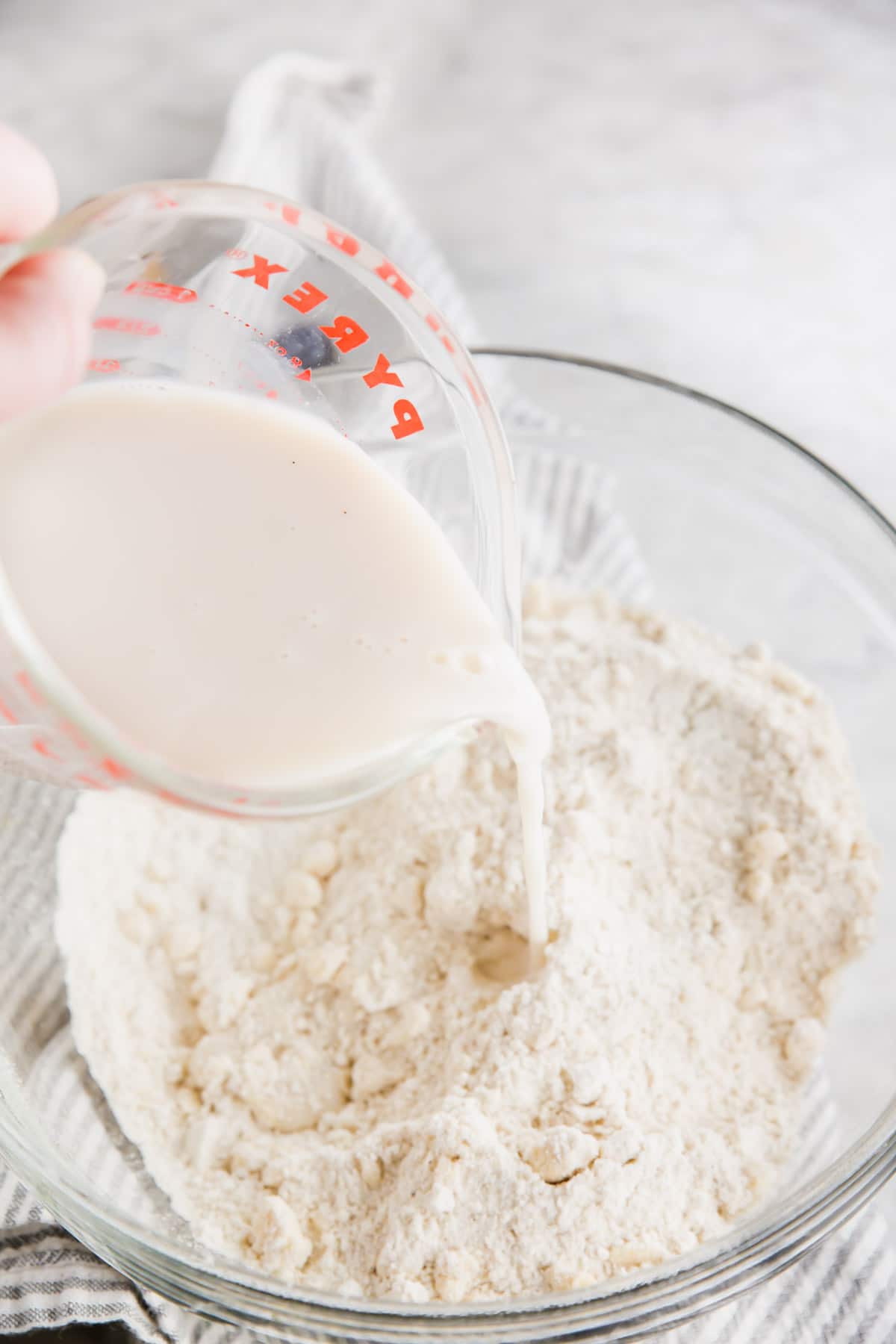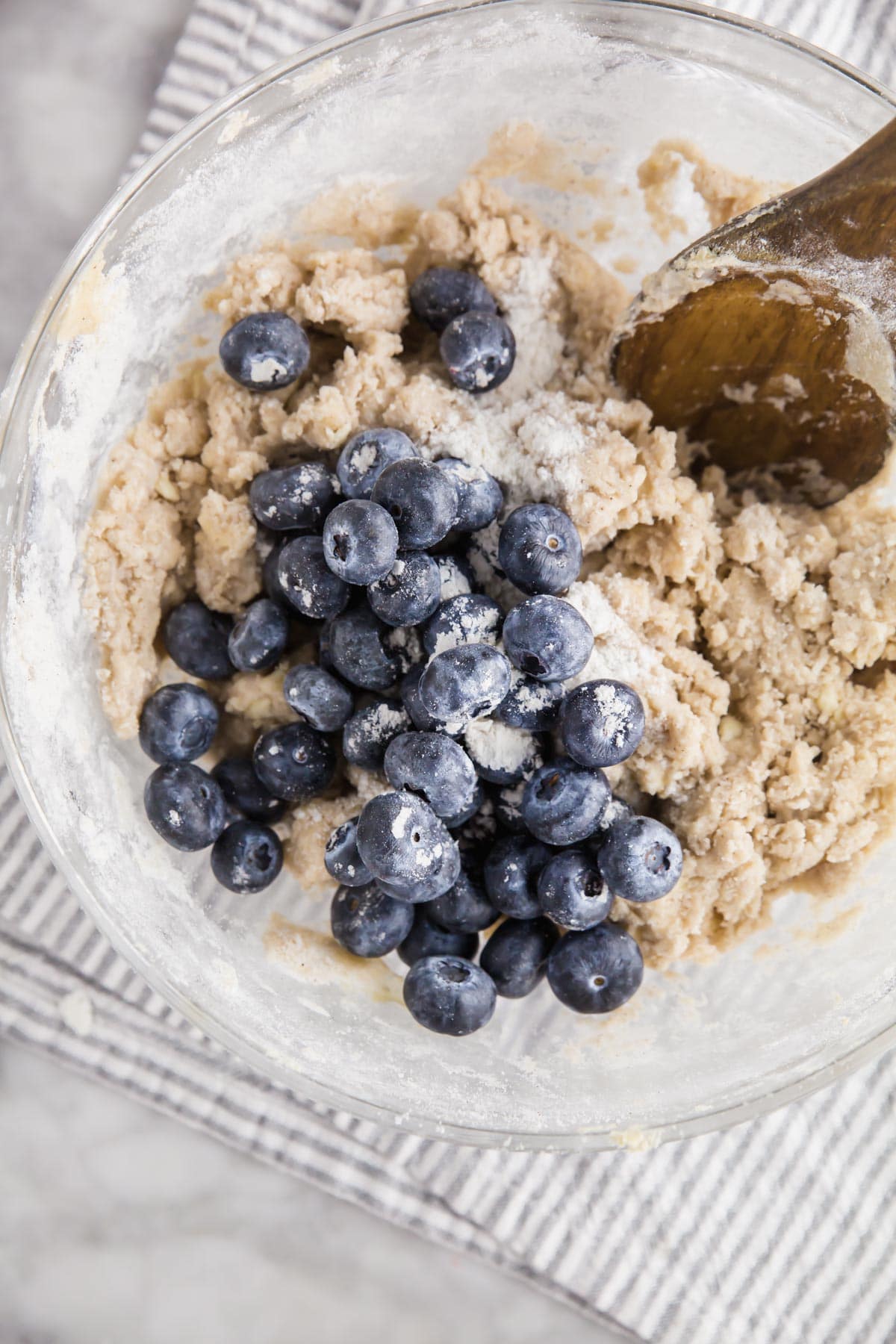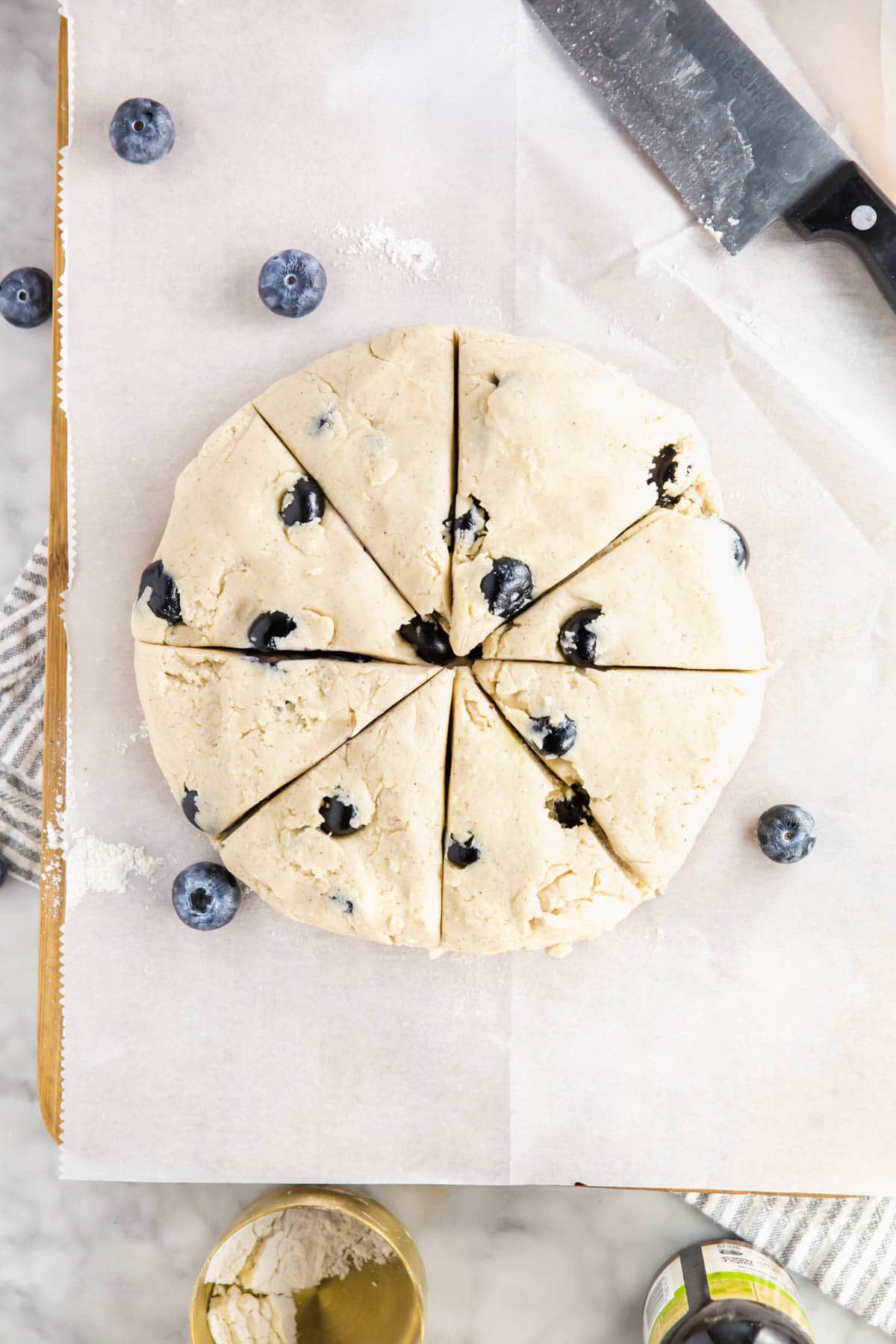
There is nothing better than a golden, gluten-free blueberry scone for breakfast. Tender and buttery, with a crispy exterior.
I used to think that scones were extremely dry bricks of pastry, but boy was I wrong! These scones are moist and such a treat for breakfast or brunch.
I originally developed this blueberry scones recipe while studying abroad in Denmark. The only oven in our dorm was in the common room in the basement. Unfortunately, the common room was closed for all but one week of my study abroad summer, which was a bummer for a girl who loves to bake.
My friend, Chris, and I had been planning to make scones since Day 1 of our trip, so when we found out the common room was open the last week we were there we wasted no time getting into the kitchen.
We were also really lucky to get blueberries that were flown in from Iceland by one of his friends.
While I still make these scones 10 years later at home, there’s something about the circumstances that the original scones were made and the tiny, wild blueberries from Iceland that will make that first batch so special.

Here’s what you’ll need to make these gluten-free scones
Ingredients: very cold butter, gluten-free flour blend, xanthan gum (if your flour blend doesn’t already contain it), granulated sugar, baking powder, salt, cinnamon, whole milk, vanilla extract, blueberries, and turbinado sugar
Equipment:
- Parchment Paper – I find that using parchment paper instead of a silpat for scones helps get that golden bottom of the scones that you really want.
- Baking Sheet
- Pastry Cutter – An easy way to cut the butter into your flour
- Food Processor – I typically use a food processor to cut my butter into my flour
Tips for Scone Success
Keep your butter cold. In order to create fluffy scones, instead of flat, dense scones you’ll need to keep your butter very cold. I like to freeze my butter and then cut it into my flour mixture. Cold butter helps make your scones fluffy and rise higher!
Measure your gluten-free flour using the spoon and level method. This means that you spoon the flour into your measuring cup and then level it off with a knife.
If you scoop your measuring cup into the bag of flour, you risk adding too much flour since it gets packed down. This will create a very dense scone!
Avoid adding too much milk. You want to add just enough milk to make the dough stick together. After adding 1/2 cup of milk, I then like to add the milk tablespoon by tablespoon until the dough is able to be formed into a ball.


How to Cut Butter into Flour
The secret to a flaky scone is cutting the cold butter into the flour mixture. “Cutting in” butter means that the butter is mixed with the flour in a way so that the butter still has clumps of butter when mixed in, typically the size of peas.
Using cold butter will help make sure that the butter doesn’t melt before it gets in the oven. When it finally hits the heat of the oven, the cold butter will create flaky layers and pockets of butter! YUM!
There are a few ways to cut butter into flour for making scones:
- Pastry cutter – This tool is probably the easiest way to cut butter into flour. If you have one, I highly recommend using one! They’re so simple to use!
- Two butter knives – This is one of the more tedious ways to cut butter into flour, but it does work! Hold a knife in each hand and cross them over each other at an angle and simultaneously slice through the mixture form the center of the bowl to the outside.
- Food processor – This is the method I typically use to cut in butter. Place the cold butter and flour mixture in the food processor and “pulse” 10-15 times until the butter is the size of peas. It is very important to not let the food processor run or pulse too many times, otherwise the butter will simple mix together with the flour which is not what we want!
- Cheese grater – You can freeze a stick of butter and then grate the frozen butter into the flour mixture with a cheese grater. This is a great trick and so easy to do if you have a block cheese grater!
Whichever way you choose to cut in your butter, make sure your butter is cold. The goal is to leave clumps of butter into the flour mixture.


FAQs and tips for making the perfect gluten-free blueberry scones
These scones are best warm and served with some butter or jam. If you are not eating the scones right after baking, it’s best to heat them up in the oven or toaster oven before serving. You can heat them in the microwave but they will lose their crispy exterior.
You can! If blueberries are not in season or available to you, you can use frozen blueberries. I like to rinse my blueberries and then pat dry with a towel. Toss with some gluten-free flour before gently folding in to the dough. Frozen blueberries are more likely to bleed into the dough but your scones will still be delicious!
It’s best to use an all-purpose gluten-free flour blend that is meant to replace wheat flour cup-for-cup. Two of my favorites are Bob’s Red Mill 1-to-1 Gluten-Free Baking Flour (in the blue bag) and King Arthur Gluten-Free Flour.
If your gluten-free flour blend already contains xanthan gum, you do not need to add it to the recipe. Xanthan gum is used as a binder in place of gluten to provide elasticity to the pastry. Many blends, such as Bob’s Red Mill 1-to-1 Gluten-Free Baking Flour already contain xanthan gum and you will not need to add it to the recipe. Check the ingredients of your flour blend to be sure.
You can freeze scone dough before baking if you want to bake them off later! After slicing the dough into wedges, place it on a baking sheet line with parchment paper and freeze for an hour. Then, transfer to an airtight freezer bag or container for storage up to 2 months.
Gluten-free scones tend to lose their freshness quicker than the gluten-filled counterparts. In fact, they’re best served warm straight from the oven. They’ll stay fresh at room temperature in an airtight container for 1-2 days, but they will lose their crisp edges.
Yes, this is my favorite way to store gluten-free scones. Let the scones cool completely after baking and then freeze on a baking sheet for an hour. Once frozen, place in a freezer bag or freezer-safe container for up to 2 months.
You can let frozen scones defrost on the counter. However, the scones are really best when warmed up. I like to heat my scones straight from frozen in the oven at 350F for about 10 minutes, until warm and crispy.

Love blueberries? Check out these other gluten-free blueberry recipes!
- Gluten-Free Blueberry Muffin Bread
- Mini Blueberry Tarts – Gluten-Free and Vegan
- Blueberry Turkey Breakfast Sausage
- Gluten-Free Blueberry Cream Cheese Muffins
- Blueberry Banana Bread – Gluten-Free and Vegan

Gluten-Free Blueberry Scones
Ingredients
For the Scones:
- 2 cups gluten-free flour blend - I used Bob's Red Mill 1-to-1 Gluten-Free Baking Flour (280g)
- 1/2 teaspoon xanthan gum - if your blend doesn't already contain it
- 1/2 cup granulated sugar - 100g
- 1 Tablespoon baking powder
- 1/2 teaspoon ground cinnamon
- 1/2 teaspoon salt
- 6 tablespoons unsalted butter - very cold and cubed (85g)
- 1/2-3/4 cup whole milk
- 1 teaspoon vanilla extract
- 1 cup fresh blueberries
For Topping:
- 1 tablespoon unsalted butter - melted
- 1 teaspoon turbinado sugar - or other coarse sugar
**Use the toggle button above to turn the instruction photos on and off!
Instructions
- Preheat oven to 425F. Line a baking sheet with parchment paper and set aside.
- Combine the gluten-free flour blend, xanthan gum (if using), sugar, baking powder, ground cinnamon, and salt in a food processor. Pulse to combine.
- Add the cubed butter to the flour mixture and pulse 10-15 times, until butter is cut into the flour mixture and is the size of peas. Do not over mix. Transfer the flour mixture to a large bowl.
- Add the vanilla extract and 1/2 cup of the milk and fold with a spatula just until combined. If the dough is still very dry and not combining, add more milk, one tablespoon at a time until the dough just comes together. You do not want it to be too wet. I typically end up adding an additional two tablespoons, but it will depend on what flour blend you use.
- Carefully mix in the blueberries, trying to ensure they do not break. If a few break, that’s okay.
- Transfer the dough to a generously floured work surface. Knead the dough into a ball.
- Roll the dough into a circle, 1-inch high and 7-inches wide.
- Using a sharp, floured knife, cut the dough circle into 8 equal triangles.
- Transfer to a parchment lined baking sheet. Brush the tops of the scones with melted butter and sprinkle lightly with turbinada sugar.
- Bake at 425F until the tops and bottoms are golden brown, 18-22 minutes.
- Transfer to a wire rack and let cool for 5 minutes before serving.
Notes
- Make sure your butter is cold and cubed into small pieces before cutting it into the flour. I like to freeze my butter to make sure it is very cold.
- If you do not have fresh blueberries, you can use frozen blueberries. I like to rinse my frozen blueberries in water and then pat dry with a towel before using to help keep them from bleeding into the dough.
- To store leftover scones, freeze in them on a baking sheet after they’ve cooled. Then, place in a freezer-safe bag or container for up to 2 months. To reheat, place in an oven at 350F for 10-15 minutes until warmed through.
Nutrition
This recipe was originally posted on August 19, 2010 and updated on April 23, 2020 with new photos, tips and tricks to help you make these gluten-free blueberry scones perfectly every time!










Thanks for sharing! Does it keep long?
They’ll stay fresh at room temperature in an airtight container for 1-2 days, but they will lose their crisp edges. I personally prefer to freeze any leftovers. Just let the scones cool completely after baking and then freeze on a baking sheet for an hour. Once frozen, place in a freezer bag or freezer-safe container for up to 2 months.